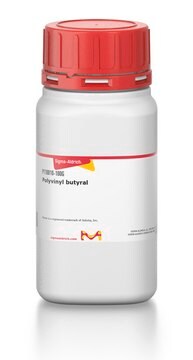189480
Poly(vinyl acetate)
average Mw ~100,000 by GPC, beads
Sinonimo/i:
Polyvinyl acetate
About This Item
Prodotti consigliati
Forma fisica
beads
PM
average Mw ~100,000 by GPC
Viscosità
17-21 sec.(25 °C, Ford, no. 4)(lit.)
Densità
1.18 g/mL at 25 °C
Temperatura di conservazione
2-8°C
Stringa SMILE
COC(=O)C=C
InChI
1S/C4H6O2/c1-3-6-4(2)5/h3H,1H2,2H3
XTXRWKRVRITETP-UHFFFAOYSA-N
Cerchi prodotti simili? Visita Guida al confronto tra prodotti
Categorie correlate
Descrizione generale
Applicazioni
- Starting material to prepare polymer fibers for gas and humidity sensor applications. Citric acid-doped PVAc nanofibrous mats can be used to develop sensors for trimethylamine gas at room temperature.
- Polymer coating for floating tablets showing a controlled drug delivery. PVAc is a suitable excipient to ensure reliable and safe drug release. PVAc-based matrix tablet flow due to intrinsic low density and high elasticity of polyvinyl acetate coating.
Codice della classe di stoccaggio
11 - Combustible Solids
Classe di pericolosità dell'acqua (WGK)
nwg
Punto d’infiammabilità (°F)
Not applicable
Punto d’infiammabilità (°C)
Not applicable
Dispositivi di protezione individuale
Eyeshields, Gloves, type N95 (US)
Certificati d'analisi (COA)
Cerca il Certificati d'analisi (COA) digitando il numero di lotto/batch corrispondente. I numeri di lotto o di batch sono stampati sull'etichetta dei prodotti dopo la parola ‘Lotto’ o ‘Batch’.
Possiedi già questo prodotto?
I documenti relativi ai prodotti acquistati recentemente sono disponibili nell’Archivio dei documenti.
I clienti hanno visto anche
Il team dei nostri ricercatori vanta grande esperienza in tutte le aree della ricerca quali Life Science, scienza dei materiali, sintesi chimica, cromatografia, discipline analitiche, ecc..
Contatta l'Assistenza Tecnica.






